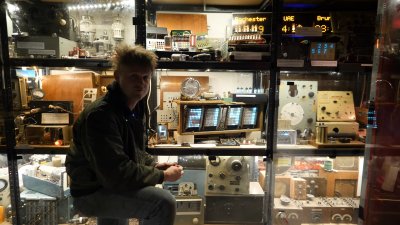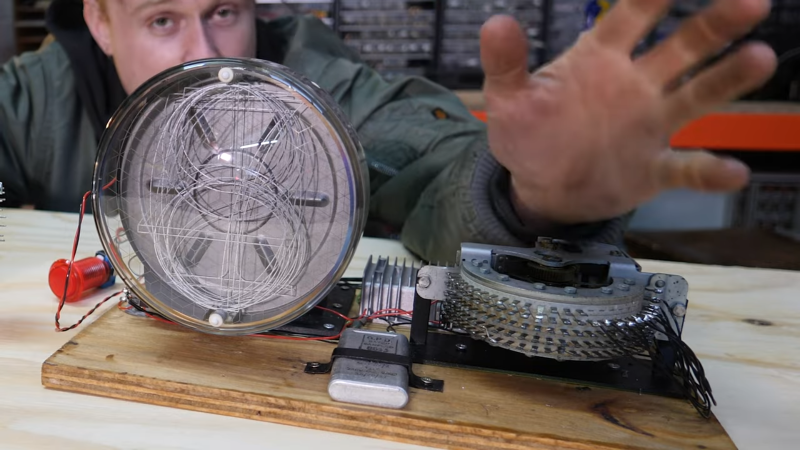[Sam Battle] is no stranger to these pages, nor is his Museum is not Obsolete. The museum was recently gifted an enormous Nixie tube created by Dalibor Farný, a B-grade (well, faulty) unit that could not be used in any of their commissioned works but was perfectly fine for displaying in the museum’s retro display display. This thing is likely the largest Nixie tube still being manufactured; although we read that it’s probably not the largest ever made, it’s still awesome.

It is fairly simple to use, like all Nixie tubes, provided you’re comfortable with relatively high DC voltages, albeit at a low current. They need a DC voltage because if you drive the thing with AC, both the selected cathode digit plate and the anode grid will glow, which is not what you need.
Anyway, [Sam] did what he does best, clamped the delicate tube in some 3D printed mounts and hooked up a driver made from stuff he scraped out of a bin in the workshop. Obviously, for someone deeply invested in ancient electromagnetic telephone equipment, a GPO (British General Post Office, now BT) uniselector was selected, manually advanced with an arcade-style push button via a relay. This relay also supplies the ~140 V for the common anode connection on the Nixie tube. The individual digit cathodes are grounded via the uniselector contacts. A typically ancient GPO-branded snubber capacitor prevents the relay contacts from arcing over and ruining the display unit. There isn’t much more to it, so if you’re in the Ramsgate, UK, area anytime soon, you can pop in and play with it for yourself.
Nixies are cool, we’ve covered Nixie projects for years, like this DIY project from ages ago. Bringing such things into the modern area is the current specialty of Dalibor Farný, with this nice video showing some of the workmanship involved. By the way — the eagle-eyed will have noticed that we covered this particular Nixie tube before, shown in the format of a large art installation. But it doesn’t hurt to get close up and play with it on the bench.\
















A bit of a tangent here.
Much of what’s on Sam’s channel seems to be synthesizer related, so not exactly my personal cup of tea. But (among a few other videos) the series he did on acquiring and bringing back to life a pipe organ (Joan’s Organ) was really interesting and entertaining for me.
Spoiler alert: he doesn’t know what he’s doing. :-)
Better than knowing what he’s doing, he gets into the guts of experiments and does interesting things outside of his comfort zone at all times. I think that skillset beats most others in application
He’s also taken on board a lot of stuff from a friend’s collection. the Compton generator set for the electronic organs of the 30’s
We have a LOT of them from the same collection that I hope to do a deep dive on how they work as they are fascinating things. Like a hammond…. but not.
Basically rotating variable capacitors to make the wiggles.
Lovely chap. We helped him out removing the self playin piano. I am utterly blown away with how quickly he put it back together again, given the amount of violence used to get it apart >.>
Love the clunk sound of the uniselector
Driving it with a rotary relay/uniselector was a great idea, I like using those just for fun and showiness in cases like this as well.
The chunky mechanical sound and odd, over-complicated look of it provides a really nice balance of interest. It’s like an opening act to the headliner of the gigantic custom tube. My only complaint is there should be a beauty sequence/montage where you slow-pan over all the parts of the device in action with some nice music, show the wipers rotating around and the coil clicking over, the glow of the different digits from different angles, all the routing of the wires in the back of the tube, etc
“Every hacker should have his own museum.”
I do! If you consider random piles of boxes with unsorted contents, and tripping hazards…
B^)
My wife doesn’t like my spare room museum very much…… :D
I’ve no idea how Sam funds his lifestyle but the world is a richer place for folks like him doing weird and wonderful stuff like this.
And for folks like Mr Farny too, amazing work on reviving a dead technology.
Making: Huge Nixie Tube prototype – Project H #18
https://www.youtube.com/watch?v=BnV98v7IQns